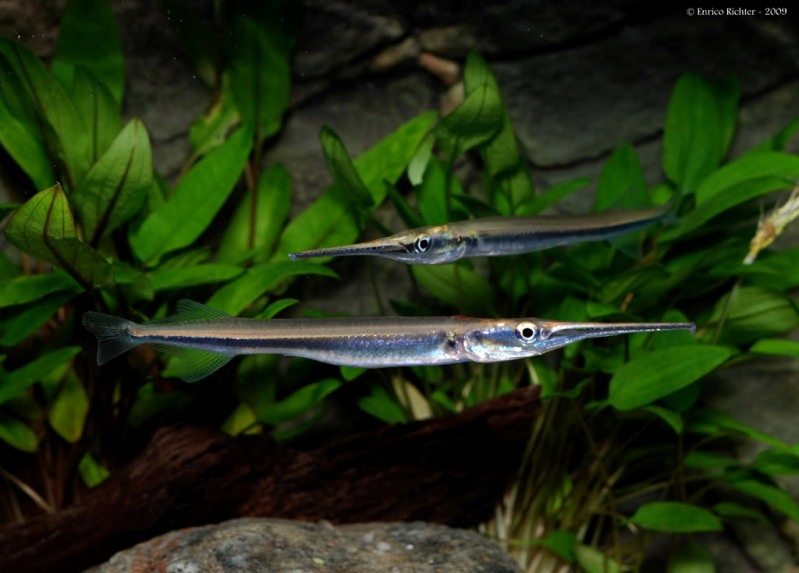
Photo: Enrico Richter
Needle Nose Gar
Name: Needle Nose Gar (Xenentodon cancila)
Origin: Asia (Rivers)
Minimum Tank Size: 6′ x 18″
Temperament: Aggressive towards smaller species
Water Conditions: 75-80 F, pH 6.5-7.5
Maximum Size: 18″
Diet: Carnivore
Before we begin, please understand this article is a mix of online research and my own opinions after housing and observing these fish. The Needle Nose Gar (Gar from here on) can reach a size of approximately 18″ in the wild, with 12″ being the common size in captivity. Most experts claim a full grown Needle Nose Gar can be happy and thrive in a 4′ long tank such as a 75 or 90 gallon. My Gar, at 5″, was in a 55 gallon aquarium and it only took him a second to dart from one side of the tank to the other. A full grown one wouldn’t be able to pick up much speed in a 4′ tank, limiting its movement and ultimately degrading its health.
Once at approximately 5-8 inches in size, these Gars can handle a wider range of aquarium temperatures and water parameters. Ideally, they would do well in an aquarium with a temperature of 78°F and neutral pH. In Florida, a mixture of tap and Reverse Osmosis water is recommended to reduce the hardness of Florida water although it is not required, since Gars can be found in both fresh and brackish waters, with the salinity of brackish water not having any effect on their health and growth. Some Gars even live in areas where the water changes from fresh to brackish depending on the season.
Gars are ferocious eaters and in the wild live on small fish, insects and amphibians. A varied diet of pre-made Hikari foods and live treats would keep your Gar healthy and happy. In the home aquaria, we can never be sure the live feeders have proper levels of protein, vitamins and other nutrients, but good quality pellet foods are always guaranteed to include ingredients the fish need. And unless quarantine measures are strictly followed, there is always the possibility of introducing organisms and diseases through live food. The Hikari carnivore Food Sticks are my go to for top feeding carnivores such as Gars, Arowanas, Killies and the African Leaf Fish. Make sure the food is small enough to fit in their narrow mouths which for juveniles would generally require the pellets to be broken into pieces.
If keeping the Gar with less aggressive fish, it is recommended to keep a few guppies and/or ghost shrimp around in the tank so as to distract the Gar from going after the more docile fish. Gars are not picky eaters and will try a taste of anything should the opportunity arise. That being said, they are also one of the easiest fish to train on feeding. Most fish are trained through hand feeding, but due to their numerous teeth and tendency to charge their prey, Gars can potentially take a chunk out of your finger, so it has become common practice to feed Gars with a pair of plastic tongs, holding pellet foods or live insects such as worms and crickets.
I generally advise aquarists to have 10x water turn-over rate in their aquariums for proper circulation. The Gars are no different, but I do recommend the flow to be divided among a number of filters and power heads at various depths so as to not create one large current across the surface. Gars thrive in low to moderate current and might have a hard time constantly fighting a strong current, especially as juveniles.
This is my general guide to caring for an Oriental Needle Nose Gar. Please keep in mind, as top feeding, fast moving predators who lunge at their prey, Gars are prone to jumping, so a tight lid with no holes is a must to keep your aquatic friend from going on an ill-fated journey!
Video: Denis Tolyarenko


